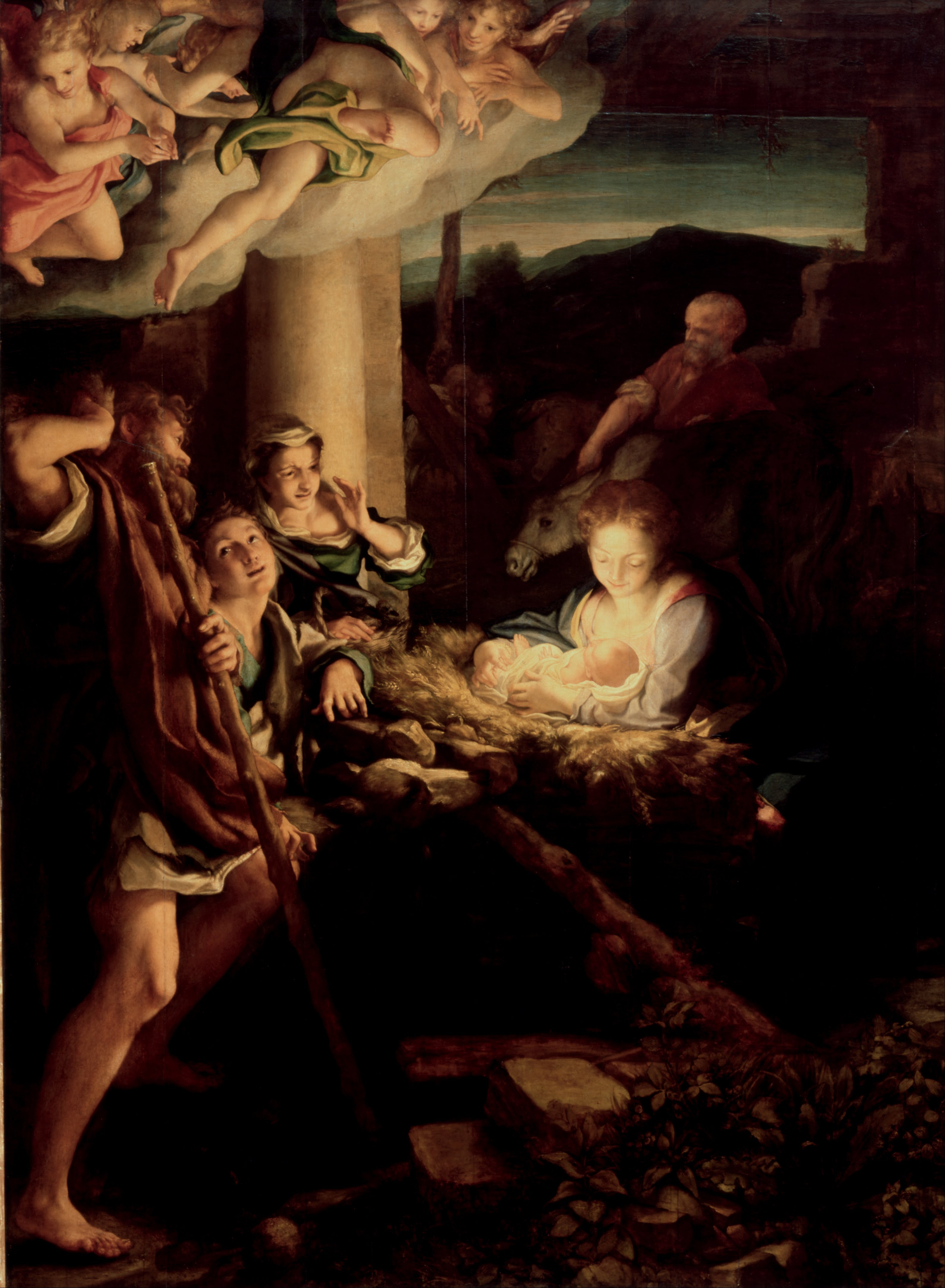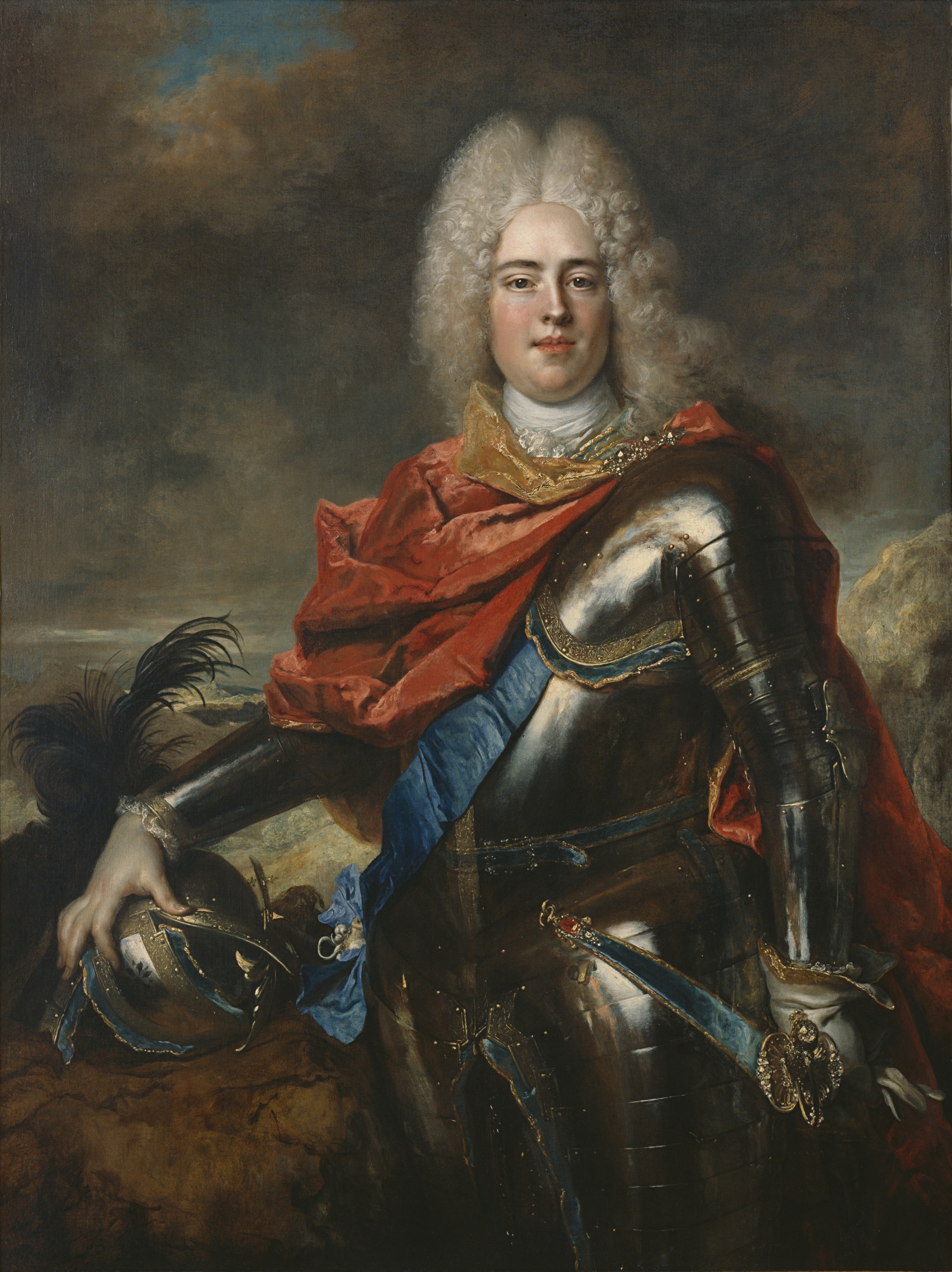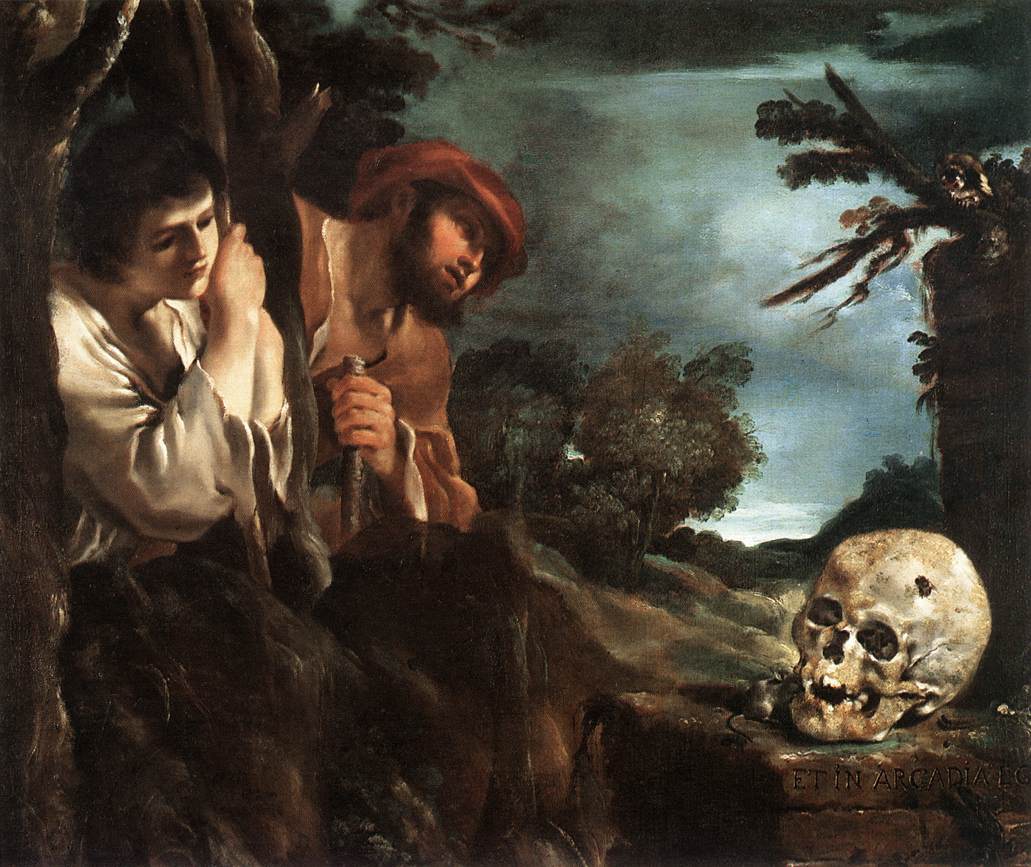|
Madonna And Child With Saint George
''Madonna and Child with Saint George'' (''Madonna di San Giorgio'') is an oil on panel painting by Correggio dating to around 1530 and now in the Gemäldegalerie in Dresden. It features the Madonna and Child in the centre under a floral dome which draws on the ''Madonna della Vittoria'' by Mantegna. To the left are Geminianus (patron saint of Modena, shown in bishop's robes and holding a model of the city assisted by a putto) and John the Baptist. To the right are saint Peter Martyr (patron saint of the confraternity for which it was painted, wearing the white and black habit of the Dominicans and with a knife in his head) and Saint George (with the dragon's head under his left foot and his sword and helmet held by three putti). History It was commissioned as an altarpiece for the high altar of the oratory of the confraternity of San Pietro Martire in Modena. It can be definitively dated thanks to the secure dating of the ''San Sebastiano Madonna'' to the mid-1520s. It was p ... [...More Info...] [...Related Items...] OR: [Wikipedia] [Google] [Baidu] |
Correggio
Antonio Allegri da Correggio (August 1489 – 5 March 1534), usually known as just Correggio (, also , , ), was the foremost painter of the Parma school of the High Italian Renaissance, who was responsible for some of the most vigorous and sensuous works of the sixteenth century. In his use of dynamic composition, illusionistic perspective and dramatic foreshortening, Correggio prefigured the Baroque art of the seventeenth century and the Rococo art of the eighteenth century. He is considered a master of chiaroscuro. Early life Antonio Allegri was born in Correggio, a small town near Reggio Emilia. His date of birth is uncertain (around 1489). His father was a merchant. Otherwise little is known about Correggio's early life or training. It is, however, often assumed that he had his first artistic education from his father's brother, the painter Lorenzo Allegri. In 1503–1505, he was apprenticed to Francesco Bianchi Ferrara in Modena, where he probably became familiar with th ... [...More Info...] [...Related Items...] OR: [Wikipedia] [Google] [Baidu] |
Giorgio Vasari
Giorgio Vasari (, also , ; 30 July 1511 – 27 June 1574) was an Italian Renaissance Master, who worked as a painter, architect, engineer, writer, and historian, who is best known for his work '' The Lives of the Most Excellent Painters, Sculptors, and Architects'', considered the ideological foundation of all art-historical writing, and the basis for biographies of several Renaissance artists, including Leonardo da Vinci and Michelangelo. Vasari designed the ''Tomb of Michelangelo'' in the Basilica of Santa Croce, Florence that was completed in 1578. Based on Vasari's text in print about Giotto's new manner of painting as a ''rinascita'' (rebirth), author Jules Michelet in his ''Histoire de France'' (1835) suggested adoption of Vasari's concept, using the term '' Renaissance'' (rebirth, in French) to distinguish the cultural change. The term was adopted thereafter in historiography and still is in use today. Life Vasari was born prematurely on 30 July 1511 in Arezzo, Tus ... [...More Info...] [...Related Items...] OR: [Wikipedia] [Google] [Baidu] |
Paintings Depicting John The Baptist
Painting is the practice of applying paint, pigment, color or other medium to a solid surface (called the "matrix" or "support"). The medium is commonly applied to the base with a brush, but other implements, such as knives, sponges, and airbrushes, can be used. In art, the term ''painting ''describes both the act and the result of the action (the final work is called "a painting"). The support for paintings includes such surfaces as walls, paper, canvas, wood, glass, lacquer, pottery, leaf, copper and concrete, and the painting may incorporate multiple other materials, including sand, clay, paper, plaster, gold leaf, and even whole objects. Painting is an important form in the visual arts, bringing in elements such as drawing, Composition (visual arts), composition, gesture (as in gestural painting), narrative, narration (as in narrative art), and abstraction (as in abstract art). Paintings can be naturalistic and representational (as in still life and landscape art, lands ... [...More Info...] [...Related Items...] OR: [Wikipedia] [Google] [Baidu] |
Collections Of The Gemäldegalerie Alte Meister
Collection or Collections may refer to: * Cash collection, the function of an accounts receivable department * Collection (church), money donated by the congregation during a church service * Collection agency, agency to collect cash * Collections management (museum) ** Collection (museum), objects in a particular field forms the core basis for the museum ** Fonds in archives ** Private collection, sometimes just called "collection" * Collection (Oxford colleges), a beginning-of-term exam or Principal's Collections * Collection (horse), a horse carrying more weight on his hindquarters than his forehand * Collection (racehorse), an Irish-bred, Hong Kong based Thoroughbred racehorse * Collection (publishing), a gathering of books under the same title at the same publisher * Scientific collection, any systematic collection of objects for scientific study Collection may also refer to: Computing * Collection (abstract data type), the abstract concept of collections in computer sc ... [...More Info...] [...Related Items...] OR: [Wikipedia] [Google] [Baidu] |
1530 Paintings
Year 153 ( CLIII) was a common year starting on Sunday (link will display the full calendar) of the Julian calendar. At the time, it was known as the Year of the Consulship of Rusticus and Rufinus (or, less frequently, year 906 ''Ab urbe condita''). The denomination 153 for this year has been used since the early medieval period, when the Anno Domini calendar era became the prevalent method in Europe for naming years. Events By place Roman Empire * Minor uprisings occur in Roman Egypt against Roman rule. Asia * Change of era name from ''Yuanjia'' (3rd year) to ''Yongxing'' of the Chinese Han Dynasty. Births * Didia Clara, daughter of Didius Julianus * Kong Rong, Chinese official and warlord (d. 208) * Zhang Hong, Chinese official and politician (d. 212 Year 212 (Roman numerals, CCXII) was a leap year starting on Wednesday (link will display the full calendar) of the Julian calendar. At the time, it was known as the Year of the Consulship of Asper a ... [...More Info...] [...Related Items...] OR: [Wikipedia] [Google] [Baidu] |
Paintings Of The Madonna And Child By Correggio
Painting is the practice of applying paint, pigment, color or other medium to a solid surface (called the "matrix" or "support"). The medium is commonly applied to the base with a brush, but other implements, such as knives, sponges, and airbrushes, can be used. In art, the term ''painting ''describes both the act and the result of the action (the final work is called "a painting"). The support for paintings includes such surfaces as walls, paper, canvas, wood, glass, lacquer, pottery, leaf, copper and concrete, and the painting may incorporate multiple other materials, including sand, clay, paper, plaster, gold leaf, and even whole objects. Painting is an important form in the visual arts, bringing in elements such as drawing, composition, gesture (as in gestural painting), narration (as in narrative art), and abstraction (as in abstract art). Paintings can be naturalistic and representational (as in still life and landscape painting), photographic, abstract, narrative ... [...More Info...] [...Related Items...] OR: [Wikipedia] [Google] [Baidu] |
Adolfo Venturi (art Historian)
Adolfo Venturi (3 September 1856, Modena – 10 June 1941, Santa Margherita Ligure) was an Italian art historian. His son, Lionello Venturi, was also an art historian. Biography He received his education in Modena and Florence, and in 1878 started working as a curator at the Galleria Estense in Modena. In 1888 he was appointed general inspector of the ''Accademia di Belle Arti di Roma''. In 1888, with Domenico Gnoli, he founded the journal, "''Archivio storico d'arte''" (after 1901 it was called "''L'Arte''"). He would remain editor of the publication up until 1940. From 1896 to 1931 he served as chair of medieval and modern art at the University of Rome.Venturi, Adolfo Dictionary of Art Historians In 1923, author John R. Eyre reported Venturi's opinion on the '' |
Augustus III Of Poland
Augustus III ( pl, August III Sas, lt, Augustas III; 17 October 1696 5 October 1763) was King of Poland and Grand Duke of Lithuania from 1733 until 1763, as well as Elector of Saxony in the Holy Roman Empire where he was known as Frederick Augustus II (german: link=no, Friedrich August II). He was the only legitimate son of Augustus II the Strong, and converted to Roman Catholicism in 1712 to secure his candidacy for the Polish throne. In 1719 he married Maria Josepha, daughter of Joseph I, Holy Roman Emperor, and became Elector of Saxony following his father's death in 1733. Augustus was able to gain the support of Charles VI by agreeing to the Pragmatic Sanction of 1713 and also gained recognition from Russian Empress Anna by supporting Russia's claim to the region of Courland. He was elected king of Poland by a small minority on 5 October 1733 and subsequently banished the former Polish king Stanisław I. He was crowned in Kraków on 17 January 1734. Augustus was s ... [...More Info...] [...Related Items...] OR: [Wikipedia] [Google] [Baidu] |
Francesco III D'Este
Francesco III d'Este (Francesco Maria; 2 July 1698 – 22 February 1780) was Duke of Modena and Reggio from 1737 until his death. Biography He was born in Modena, the son of Rinaldo d'Este, Duke of Modena, and Duchess Charlotte of Brunswick-Lüneburg. During his reign, the duchy was bankrupted by the Wars of the Spanish, Polish, and Austrian Successions. As a result, Francesco was forced to sell the most precious artworks of the Estense Gallery. He was a careful administrator but most of the duchy's financial policy was in the hands of the Austrian plenipotentiary, Beltrame Cristiani. Among his measures, the urban renovation of Modena and the construction of the Via Vandelli, connecting the city to Tuscany. Francesco also was the interim Governor of the Duchy of Milan between 1754 and 1771. He died in 1780 in his villa at Varese. His son Prince Ercole succeeded him. Family and children In 1721, he married Charlotte Aglaé d'Orléans (1700–1761), a daughter of Philip ... [...More Info...] [...Related Items...] OR: [Wikipedia] [Google] [Baidu] |
Girolamo Tiraboschi
Girolamo Tiraboschi S.J. (; 18 December 1731 – 9 June 1794) was an Italian literary critic, the first historian of Italian literature. Biography Born in Bergamo, he studied at the Jesuit college in Monza, entered the order, and was appointed in 1755 professor of eloquence in the University of Milan. There he produced (1766–1768) ''Vetera humiliatorum monumenta'' (3 vols), a history of the extinct order of the Humiliati, which made his literary reputation. Nominated in 1770 as librarian to Francis III, duke of Modena, he turned to account the copious materials there accumulated for the composition of his ''Storia della letteratura italiana''. This vast work, in which Italian literature from the time of the Etruscans to the end of the 17th century is traced in detail, occupied eleven years, 1771–1782, and the thirteen quarto volumes embodying it appeared successively in Modena Modena (, , ; egl, label=Emilian language#Dialects, Modenese, Mòdna ; ett, Mutna; l ... [...More Info...] [...Related Items...] OR: [Wikipedia] [Google] [Baidu] |
Guercino
Giovanni Francesco Barbieri (February 8, 1591 – December 22, 1666),Miller, 1964 better known as Guercino, or il Guercino , was an Italian Baroque painter and draftsman from Cento in the Emilia region, who was active in Rome and Bologna. The vigorous naturalism of his early manner contrasts with the classical equilibrium of his later works. His many drawings are noted for their luminosity and lively style. Biography Giovanni Francesco Barbieri was born into a family of peasant farmers in Cento, a town in the Po Valley mid-way between Bologna and Ferrara.Mahon, 1937a Being cross-eyed, at an early age he acquired the nickname by which he is universally known, Guercino (a diminutive of the Italian noun '' guercio'', meaning 'squinter').Turner, 2003 Mainly self-taught, at the age of 16, he worked as apprentice in the shop of Benedetto Gennari, a painter of the Bolognese School. An early commission was for the decoration with frescos (1615–1616) of Casa Pannini in Cento, ... [...More Info...] [...Related Items...] OR: [Wikipedia] [Google] [Baidu] |
Francesco I D'Este
Francesco I d'Este (6 September 1610 – 14 October 1658) was Duke of Modena and Reggio from 1629 until his death. The eldest son of Alfonso III d'Este, he became reigning duke after his father's abdication. Biography The pestilence of 1630–1631 killed 70% of Modena's inhabitants. After the outbreak of the Thirty Years' War he sided with Spain and invaded the duchy of Parma, but upon visiting to Spain to claim his reward, he could only acquire Correggio by a payment of 230,000 florins. Later followed the First War of Castro, in which Francesco's Modena joined Venice and Florence and sided with the Dukes of Parma against Barberini Pope Urban VIII, aiming to reconquer Ferrara. The war ended without any particular gain for the Modenese. As again no help had come from Spain, Francesco allied with France through the intercession of Cardinal Mazarin. When he however failed to conquer Cremona, and as the situation of the Thirty Years' War seemed to be favourable for Spain, ... [...More Info...] [...Related Items...] OR: [Wikipedia] [Google] [Baidu] |






